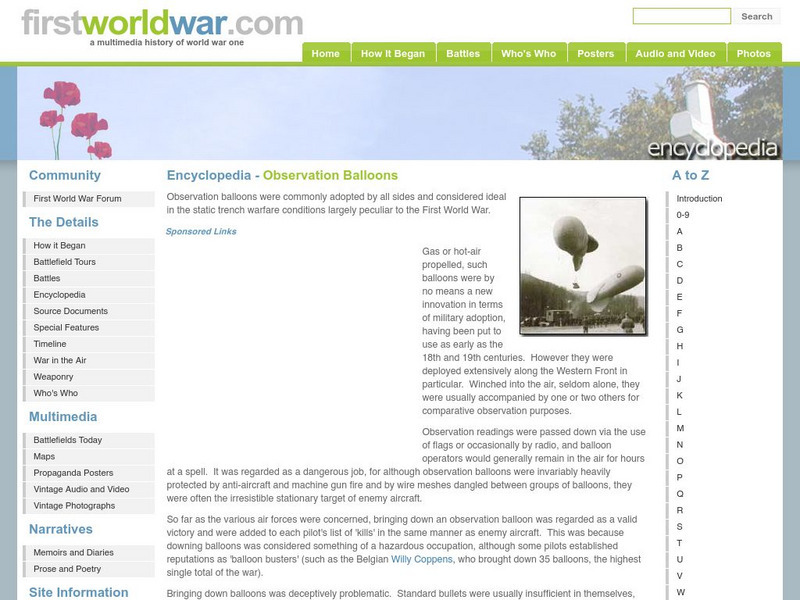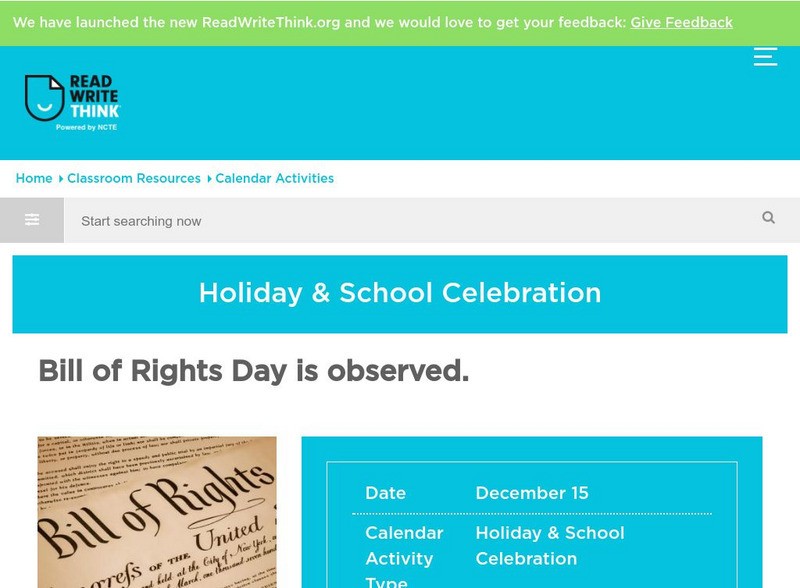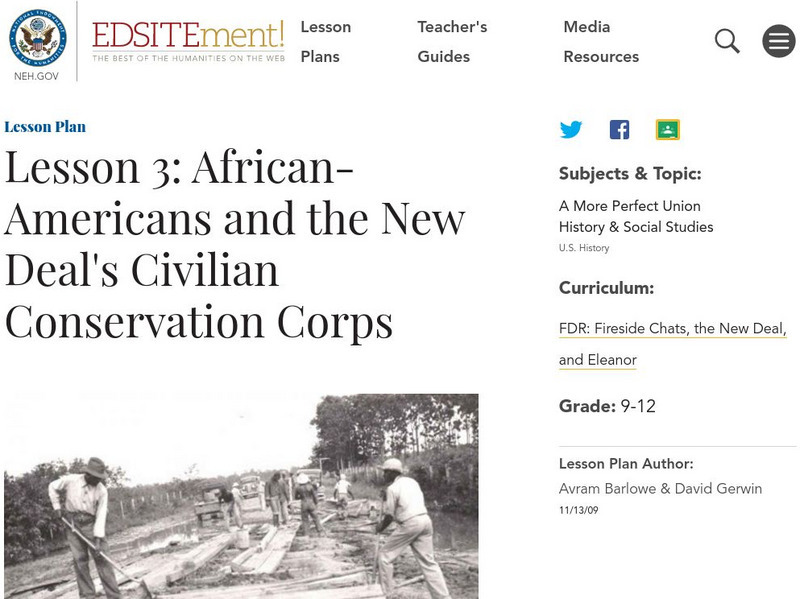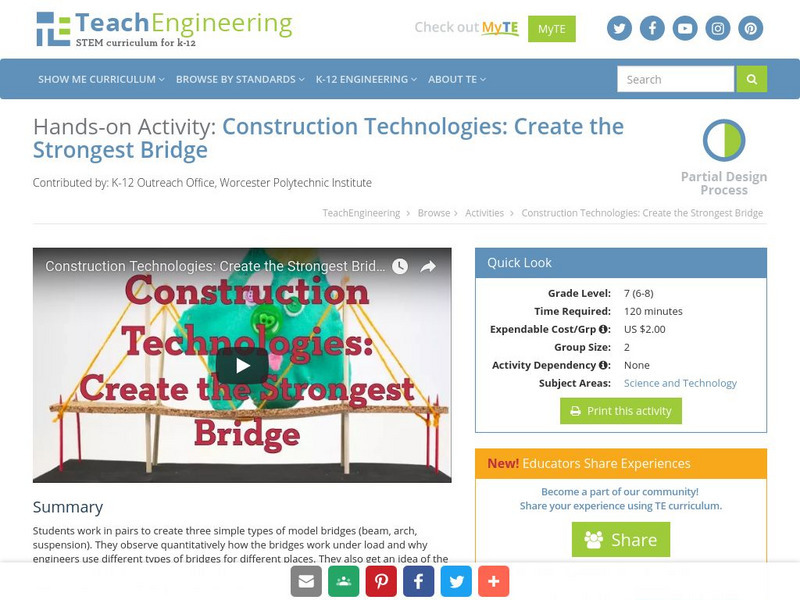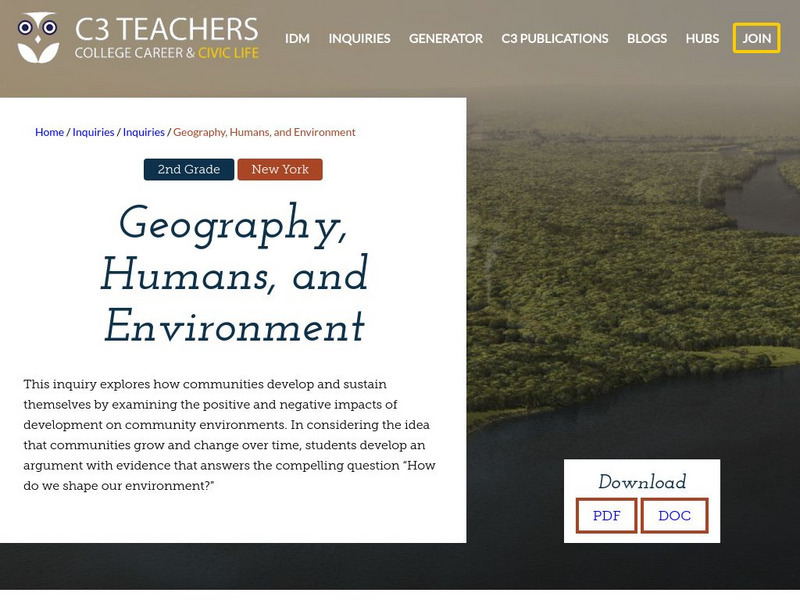University of Florida
Baldwin Library: The Observing Eye
A scanned copy of the 1853 publication of The Observing Eye by Anne Wright, a nonfiction book for children.
First World War
First World war.com: Encyclopedia Observation Balloons
Describes how observation balloons were used during World War I, the dangers of piloting one, and difficulties the enemy faced in trying to bring one down.
Library of Congress
Loc: Photo Analysis Presenting the Statue of Liberty
The ability to examine a primary source is a gateway to building critical thinking skills and constructing knowledge. This lesson provides the students an opportunity to observe similarities and differences between 2 visual images,...
Annenberg Foundation
Annenberg Learner: Against All Odds: Experimental Design
Video program explains the difference between observation and experiment and the principles of experiment design. Lesson draws on real-life example of heart disease study and a double-blind experiment. [28:39]
ReadWriteThink
Read Write Think: Bill of Rights Day Is Observed
Contains plans for seven lessons that ask students to examine Supreme Court cases that have impacted civil liberties in the United States. Students work in groups and report their findings using PowerPoint presentations. In addition to...
PBS
Pbs Learning Media: Earth's Systems Collection: Bringing the Universe to America's Classroom
Explore different landforms and bodies of water around the world, observe and map landforms and water features, and practice observation and analysis skills through a virtual landscape and animated adventure in Plum's Island Explorer....
Sophia Learning
Sophia: Supporting Details Explained
This slideshow focuses on supporting details; it discusses their purpose, the audience, and the point to be made. It lists the five most common types of supporting details: facts, statistics, opinions, examples, and personal observations...
Illustrative Mathematics
Illustrative Mathematics: S Ic Words and Music Ii
Given a hypothetical situation, students will decide if this is an experiment or observational study and why? They will also learn the importance of random assignments in this particular example. Explanations are provided.
PBS
Pbs Learning Media: Plum's Island Explorer: Land and Water
Navigate around the island to explore various landforms and water bodies in this interactive game from PLUM LANDING. Journey around the island and pick up trash to unlock information - including videos and ground-level and aerial images...
National Endowment for the Humanities
Neh: Edsit Ement:african Americans and the New Deal's Civilian Conservation Corps
One of the New Deal programs, the Civilian Conservation Corps, provided over a quarter of a million young black men with jobs and was thus another arena of the struggle for greater equality. This lesson explores that struggle and its...
Smithsonian Institution
Smithsonian Learning Lab: Every Picture Has a Story
Smithsonian Education presents "Every Picture Has a Story". Teachers can download this comprehensive teaching package in which students examine some of the millions of photographs in the Smithsonian. This amazing teaching package comes...
Discovering Lewis & Clark
Discovering Lewis & Clark: Milk River
Discover facts about the valley of the river Lewis and Clark named Milk and read about their observations.
Discovering Lewis & Clark
Discovering Lewis & Clark: Fort Mountain (Square Butte)
Features images and a vivid description of "Fort Mountain" or Square Butte as it is now called. Also, includes the observations of Meriwether Lewis from July of 1805.
Discovering Lewis & Clark
Discovering Lewis & Clark: On Jefferson's River
This section from Discovering Lewis & Clark provides observations and views from the expedition's journey down the Jefferson River in 1805.
Other
The Carter Center: Postelection Statement on Mali Elections, June 7, 2002
This is the final statement issued by The Carter Center regarding the 2002 democratic elections in Mali, Africa. It covers in detail the Mali election process, counting and tabulation, constitutional court, observers, voter...
Utah Education Network
Uen: Tonight's Homework Watch Cartoons
Learners will make observations about different types of advertisements. Students will watch distinguish the types of advertisements shown during commercial breaks associated with their cartoons and the news.
NOAA
Noaa: Chesapeake Bay Interpretive Buoy System: Data in the Classroom
NOAA Smart Buoys collect and transmit real-time weather, water conditions, and water quality data. Chesapeake Exploration gives teachers and their students unprecedented access to lessons designed around real-time observational data from...
TeachEngineering
Teach Engineering: Construction Technologies: Construct the Strongest Bridge
In this activity, students will work in pairs to create three simple types of bridges. They will observe quantitatively how the bridges work under load and why engineers use different types of bridges for different places. They also will...
Other
Loughborough Univ.: Young Children's Problem Solving in Design and Technology
This 1997 article from the Journal of Design & Technology Education at Loughborough University in the UK looked at the problem-solving strategies young children use in design and technology tasks, both independently and when working...
Other
Kid Citizen: Capture the Flag
By investigating primary sources displaying the American flag, students will explore the various ways people use the flag to show characteristics such as pride, loyalty, and unity for the nation. In this tutorial, students will engage in...
Stanford University
Stanford University: Conventionality of Simultaneity
This site from Stanford University is on the topic of simultaneity in relativity.
NOAA
Noaa: Be a Citizen Weather Reporter [Pdf]
Report the local weather to your community after deciding which data to collect and reading some of the National Weather Service's forecasting tips for amateur weather reporters.
C3 Teachers
C3 Teachers: Inquiries: Geography, Humans, and Environment
A learning module on how humans change and shape their local environment. It includes several supporting questions accompanied by formative tasks and source materials, followed by a summative performance task. Topics covered include...
National Science Teachers Association
Nsta: Science & Engineering Practices: Obtaining, Evaluating, Communication
This site from NSTA includes a progression of the Science and Engineering Practice for obtaining, evaluating, and communicating information. In addition, thereare performance expectations that make use science and engineering practices.
Other popular searches
- Observation and Inferences
- Observation Skills
- Student Teacher Observation
- Observation Inference
- Making Observations
- Scientific Observation
- Inference and Observation
- Observation Log
- Weather Observation Chart
- Observations and Inferences
- Direct Observation
- Science Observation Skills

